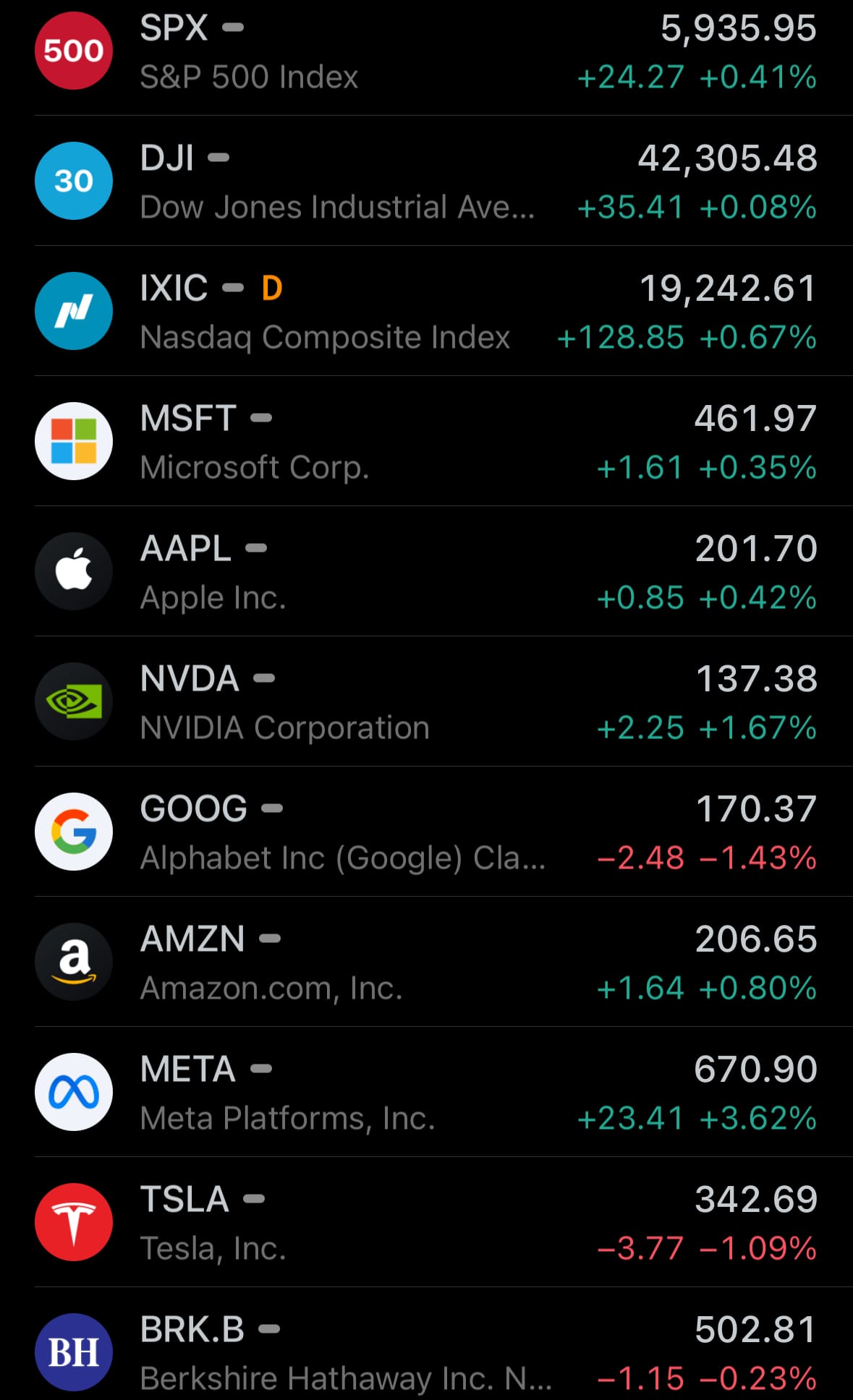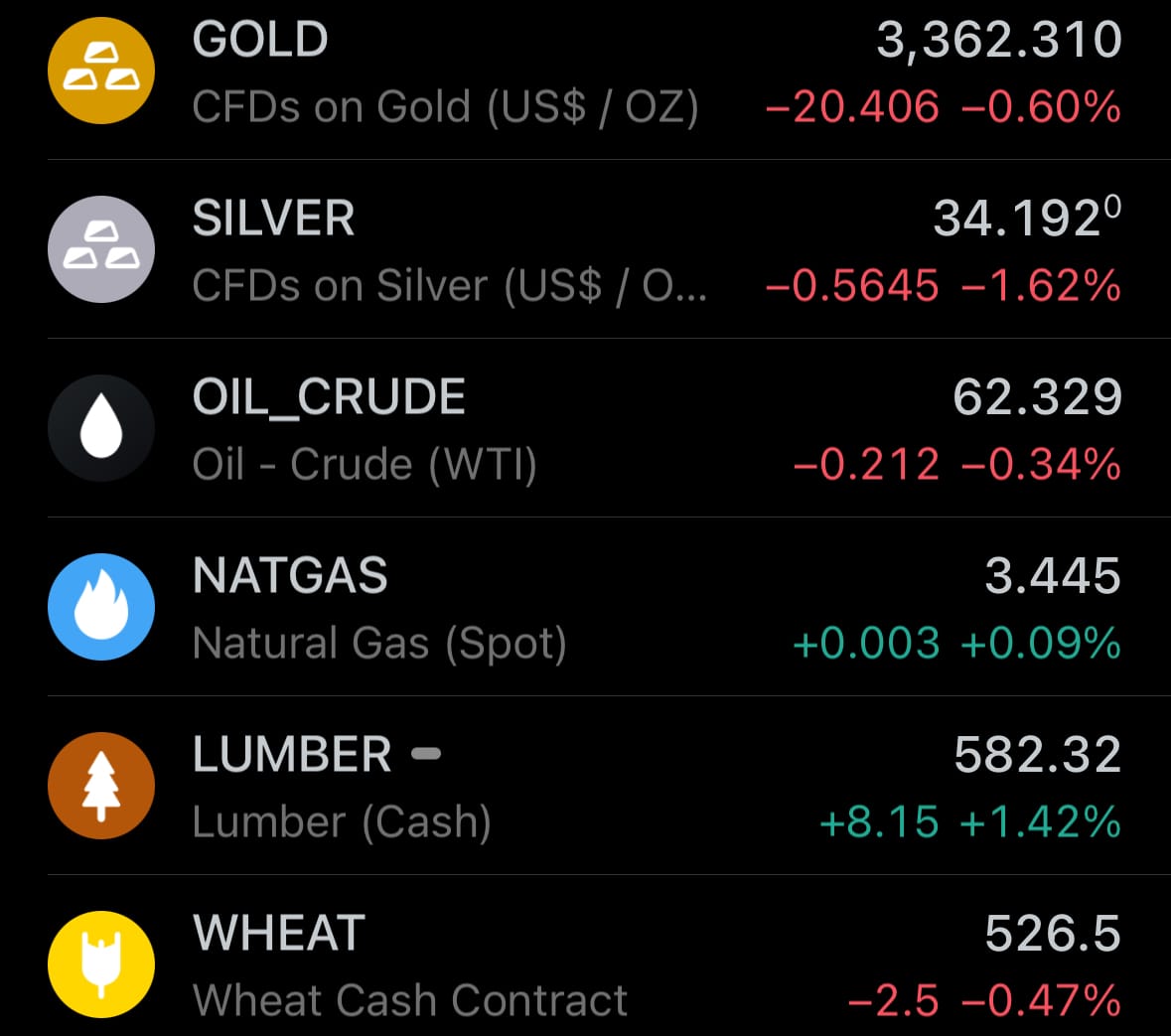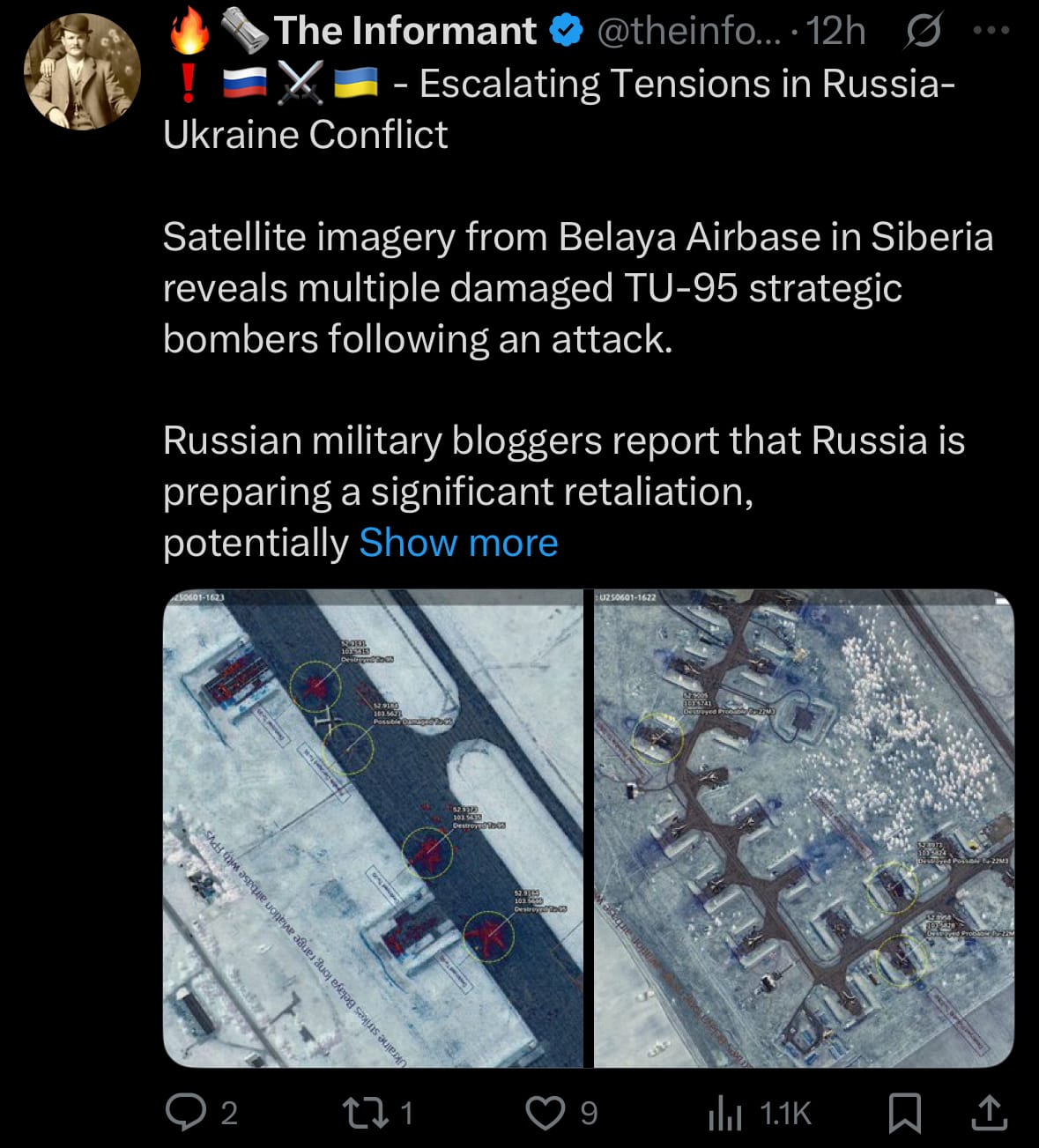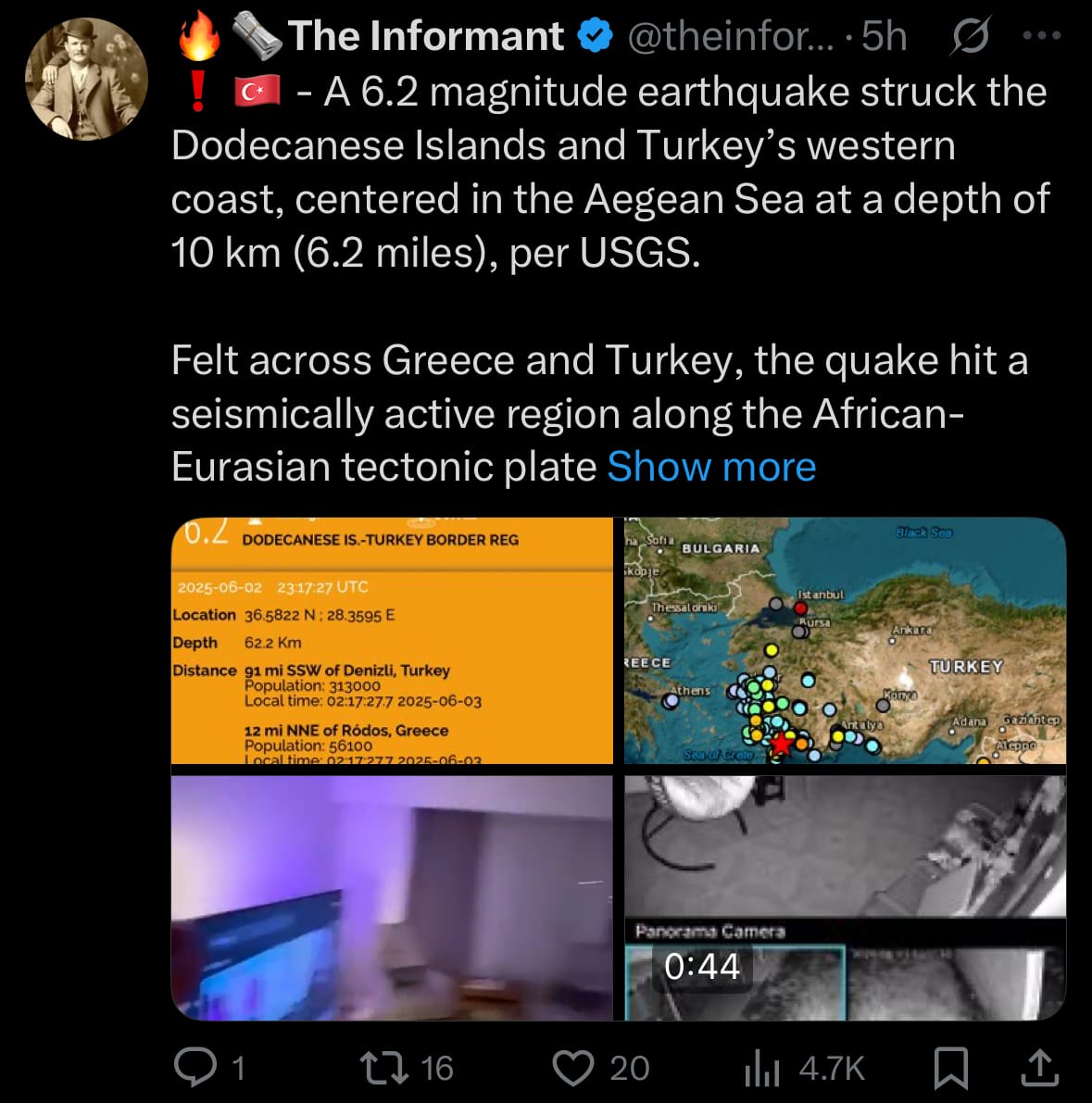Tuesday☕️

Economics & Markets:
- Yesterday’s U.S. stock market:

- Today’s commodity market:

- Today’s crypto market:

Geopolitics & Military Activity:
- On June 1, 2025, Belaya Airbase in Siberia’s Usolsky district, Irkutsk region, was attacked by Ukraine, with satellite imagery revealing damage to several Tu-95 strategic bombers. The airbase, a key facility for Russia’s long-range aviation, is located 4,200 to 5,500 kilometers (2,600 to 3,400 miles) from Ukraine’s eastern border, highlighting the significant distance from the conflict's frontline. The attack, which marks a rare strike deep within Russian territory, involved the use of drones, though details about the operation and those responsible remain limited.

- The incident occurs amid the ongoing Russia-Ukraine conflict, which has seen both sides target military infrastructure. The strike’s impact on Russia’s strategic capabilities and the broader conflict remains uncertain, but it reflects the increasing reach of military operations.
Environment & Weather:
- Yesterday, June 2, 2025, a 6.2 magnitude earthquake struck the Dodecanese Islands and Turkey’s western coast, with its epicenter in the Aegean Sea at a depth of 10 km (6.2 miles), according to the USGS. The epicenter was located at 36.5822°N, 28.3955°E, approximately 91 km (56 miles) southwest of Denizli, Turkey, and 132 km (82 miles) northeast of Rhodes, Greece. The quake was felt widely across southern Greece, western Turkey, and even in parts of Egypt and Syria, as reported by India TV News. Initial updates indicate one teenager was killed and at least 69 people were injured in Marmaris, Turkey, a popular resort town, with many residents fleeing their homes.

- The Aegean Sea, the second region affected, is a seismically active zone due to the African plate subducting beneath the Eurasian plate, a tectonic boundary prone to frequent earthquakes. The European-Mediterranean Seismological Centre (EMSC) reported aftershocks ranging from 2.0 to 4.0 magnitude, with some sources like Volcano Discovery noting a 2.6 magnitude aftershock southeast of Bodrum, Turkey. Local authorities in both Greece and Turkey advised residents to avoid damaged buildings, though no tsunami occurred despite an initial alert mentioned on X.
Space:
- Yesterday, June 2, 2025, Rocket Lab launched its Electron rocket for the 65th time from Launch Complex 1 on New Zealand’s Mahia Peninsula, marking the second of five BlackSky Technology missions to deploy its next-generation Gen-3 satellites. The mission, named "Full Stream Ahead," successfully placed a single Gen-3 satellite into a 470 km (292-mile) low Earth orbit for BlackSky, an American geospatial intelligence company focused on Earth observation. This launch, confirmed by sources like Spaceflight Now, followed the first Gen-3 deployment in February 2025, advancing BlackSky’s goal of enhancing its satellite constellation.

- The commercial constellation of Gen-3 satellites is designed to produce images with 50-centimeter resolution and host multiple sensors, including shortwave infrared (SWIR), as noted on BlackSky’s website. The improved resolution and enhanced spectral diversity of the Gen-3 satellites aim to expand BlackSky’s ability to provide real-time information to its customers, supporting applications like high-cadence monitoring and AI-enabled analytics.

- Today, June 3, 2025, SpaceX launched a Falcon 9 rocket from Space Launch Complex 40 at Cape Canaveral Space Force Station in Florida, deploying 23 Starlink v2-mini satellites into low Earth orbit. The mission, Starlink Group 12-19, included 13 Direct to Cell and 10 standard v2-mini satellites. The Starlink v2-mini satellites aim to provide global high-speed internet, with Direct to Cell enabling mobile connectivity without specialized hardware.
Statistic:
- Largest assets on Earth by market capitalization:
- Gold: $22.758T
- 🇺🇸 Microsoft: $3.433T
- 🇺🇸 NVIDIA: $3.350T
- 🇺🇸 Apple: $3.012T
- 🇺🇸 Amazon: $2.193T
- Bitcoin: $2.095T
- 🇺🇸 Alphabet (Google): $2.058T
- Silver: $1.929T
- 🇺🇸 Meta Platforms: $1.686T
- 🇸🇦 Saudi Aramco: $1.611T
- 🇺🇸 Broadcom: $1.169T
- 🇺🇸 Tesla: $1.103T
- 🇺🇸 Berkshire Hathaway: $1.085T
- 🇹🇼 TSMC: $1.010T
- 🇺🇸 Walmart: $798.24B
- 🇺🇸 JPMorgan Chase: $735.51B
- 🇺🇸 Visa: $699.83B
- 🇺🇸 Eli Lilly: $670.71B
- 🇨🇳 Tencent: $584.05B
- SPDR S&P 500 ETF Trust: $543.97B
- 🇺🇸 Mastercard: $527.79B
- 🇺🇸 Netflix: $518.76B
- 🇺🇸 Costco: $468.73B
- 🇺🇸 Oracle: $467.10B
- 🇺🇸 Exxon Mobil: $444.10B
History:
- The history of particle accelerators began in the early 20th century as scientists sought to explore atomic and subatomic structures. Around 1920, early high-voltage accelerators used two electrodes in a vacuum to create a potential drop of about 100 kV, accelerating charged particles. By 1932, the first true particle accelerator was built, delivering a 400 kV collimated beam, and in the 1930s, accelerators were developed to study atomic nuclei. The synchrotron, proposed by physicist Mark Oliphant in 1943, allowed for higher energies, leading to major advancements. The Large Hadron Collider (LHC) at CERN, operational since 2009, became the largest and highest-energy accelerator, enabling groundbreaking research into elementary particle physics.
- Today, over 30,000 particle accelerators exist worldwide, with more than 97% used for commercial purposes. They function by accelerating charged particles, like electrons or protons, using electric fields, then steering them with magnetic fields to collide with targets or other particles. These collisions produce new particles or radiation, which are analyzed to study matter’s fundamental properties. In medicine, accelerators create radioisotopes for imaging and radiation therapy for cancer treatment; in industry, they enable radiography and sterilization of biological materials.
Image of the day:

Thanks for reading!
Earth is complicated, we make it simple.
Click image to view the Earth Intelligence System:



Support/Suggestions Email:
earthintelligence@earthintel.news




